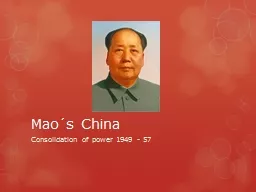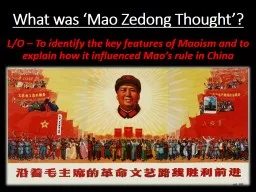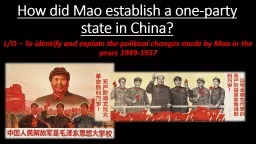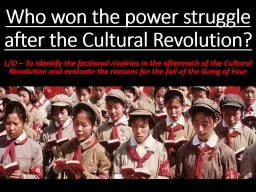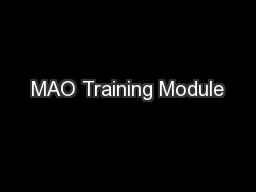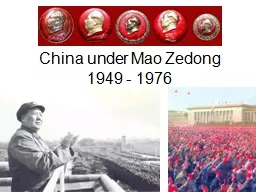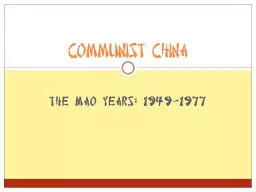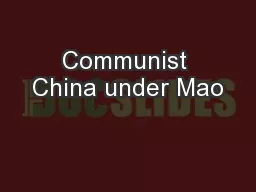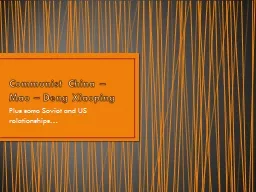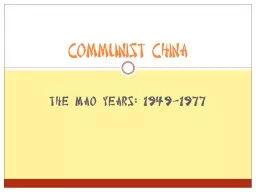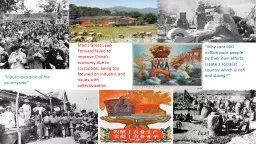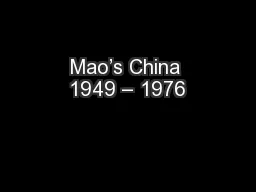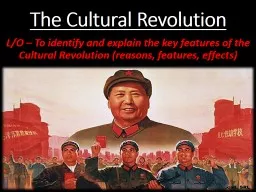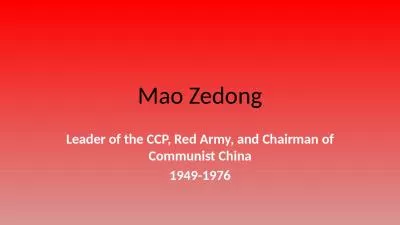PPT-Mao´s China
Author : lois-ondreau | Published Date : 2016-07-05
Consolidation of power 1949 57 Problems and challenges for Maos regime Infrastructure considerable damages after so many years of war Economy corruption wide spread
Presentation Embed Code
Download Presentation
Download Presentation The PPT/PDF document "Mao´s China" is the property of its rightful owner. Permission is granted to download and print the materials on this website for personal, non-commercial use only, and to display it on your personal computer provided you do not modify the materials and that you retain all copyright notices contained in the materials. By downloading content from our website, you accept the terms of this agreement.
Mao´s China: Transcript
Consolidation of power 1949 57 Problems and challenges for Maos regime Infrastructure considerable damages after so many years of war Economy corruption wide spread inflation high industry undeveloped major reconstruction needed. Mao’s Legacy. Key Questions. What was Maoism?. Who were the major figures in the PRC under Mao and what were the major events during his rule?. Who were the contenders to be his successor upon his death in 1976?. L/O – To identify the key features of Maoism and to explain how it influenced Mao’s rule in China. Origins of Mao Zedong Thought. Mao Zedong Thought or . Maoism. was shaped by Mao’s upbringing and early life.. L/O – To identify and explain the political changes made by Mao in the years 1949-1957. The ‘One-Party State’. From 1949 China became a . one party state. . All other parties were suppressed in a series of . L/O – To identify the factional rivalries in the aftermath of the Cultural Revolution and evaluate the reasons for the fall of the Gang of Four. ‘A Great and Decisive Victory’. The . 9. th. Party Congress . MAO login into . mFMS. . MAO’s can login into . mFMS. web . application. . by clicking onto ‘Registration and Data Upload Services’ on www.mfms.nic.in and providing login credentials received on mobile.. 1949 - 1976. Outline. GMD-CCP Civil War (1946-1949). Recovery and Socialism (1949-1956). Rethinking the Soviet model (1956-1957). Great Leap Forward (1958-1961). Recovery & growing elite division (1962-5). Communist China. The . Good Years: 1949-1958. China Packet III, Assignment 1. Assignment 1. New Expectations. Once the Nationalists were defeated, . Chairman Mao Zedong . and China’s Communists brought changes to every village. When dedicated Communist Party members arrived in a village to enact changes, he or she (usually) had the support of grateful peasants. . “We must have faith in the masses and we must have faith in the Party. These are two cardinal principles. If we doubt these principles, we shall accomplish nothing.”. Mao Zedong. “Protect the interests of the youth, women and children - provide assistance to young students who cannot afford to continue their studies, help the youth and women to organize in order to participate on an equal footing in all work useful to the war effort and to social progress, ensure freedom of marriage and equality as between men and women, and give young people and children a useful education....”. Plus some Soviet and US relationships…. Two Chinas. 1949 . PRC Mainland. Republic of China (Taiwan). Taiwan holds legal status and UN recognition until 1979 (Carter). Communist China Goals. Single-party state led by Mao. Communist China. The . Good Years: 1949-1958. China Packet III, Assignment 1. Assignment 1. New Expectations. Once the Nationalists were defeated, . Chairman Mao Zedong . and China’s Communists brought changes to every village. When dedicated Communist Party members arrived in a village to enact changes, he or she (usually) had the support of grateful peasants. . “Industrialization of the countryside”. “Why cant 600 million poor people by their own efforts create a socialist country which is rich and strong?”. Thesis:. Mao’s Great Leap Forward failed to improve China’s economy due to corruption, being too focused on industry, and issues with collectivization.. Introductory Lesson . What does China mean to you? . What does this man mean to you? (if anything?) . Do you know any of these places? . B. C. D. A. E. F. Who was responsible for the most deaths…? . Mao Resigns. Mao . resigned. as President of China in . 1959. . He remained as . Chairman. of the CCP. China was now controlled by three leading Communists:. President, . Liu . Shaoqi. Prime Minister, . 1949-1976. The Life of Mao Zedong: Childhood. 1875. 1893. 1907. 1910. The Life of Mao Zedong: School Years. 1911. 1913. 1919. 1920. The Life of Mao Zedong: Political Involvement & early days of the CCP.
Download Document
Here is the link to download the presentation.
"Mao´s China"The content belongs to its owner. You may download and print it for personal use, without modification, and keep all copyright notices. By downloading, you agree to these terms.
Related Documents

